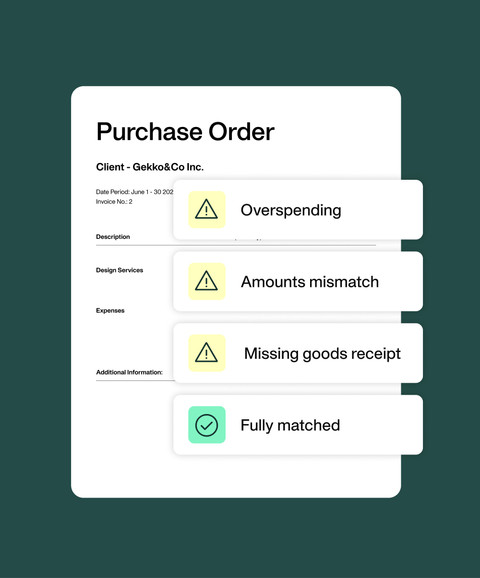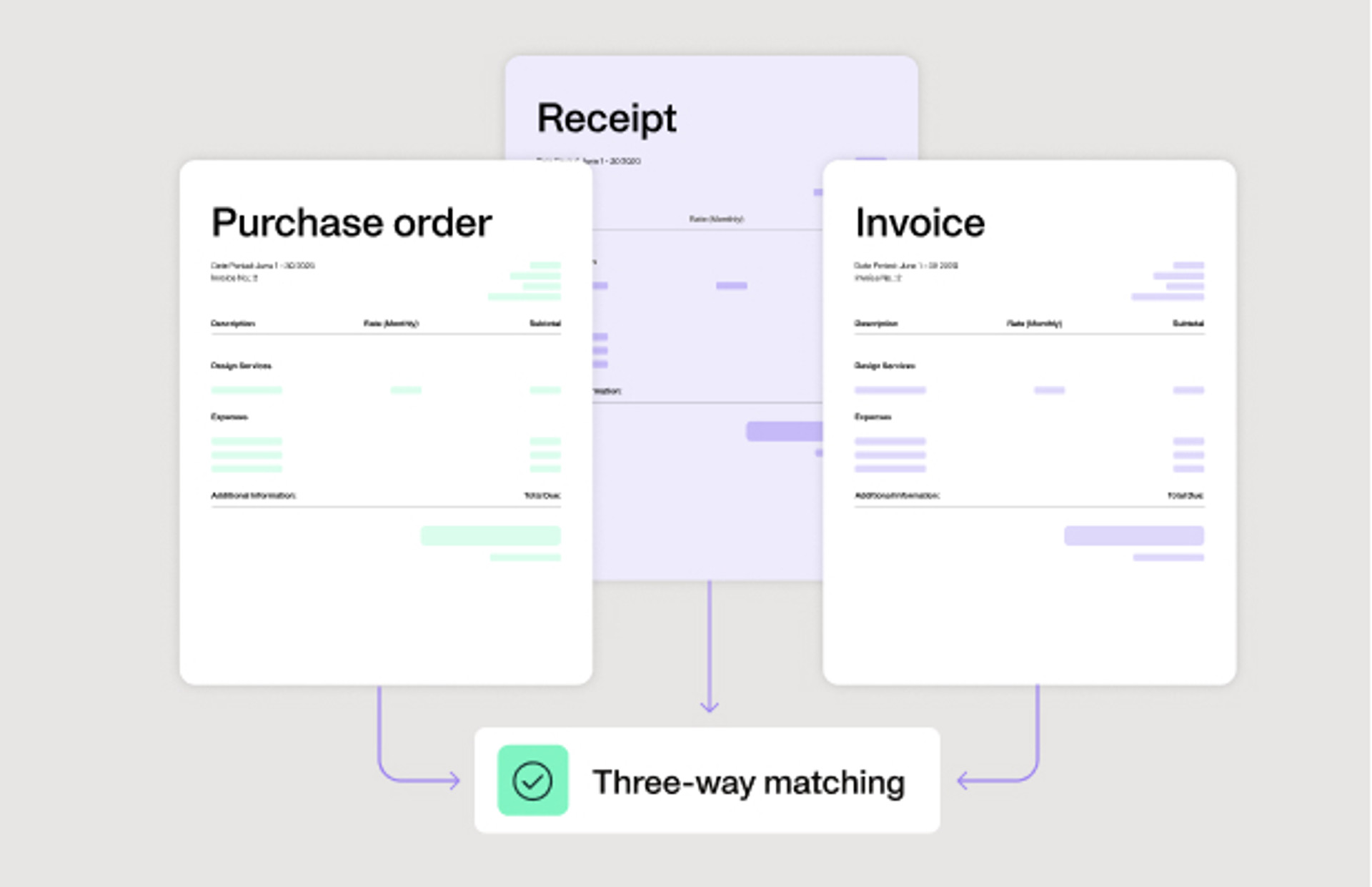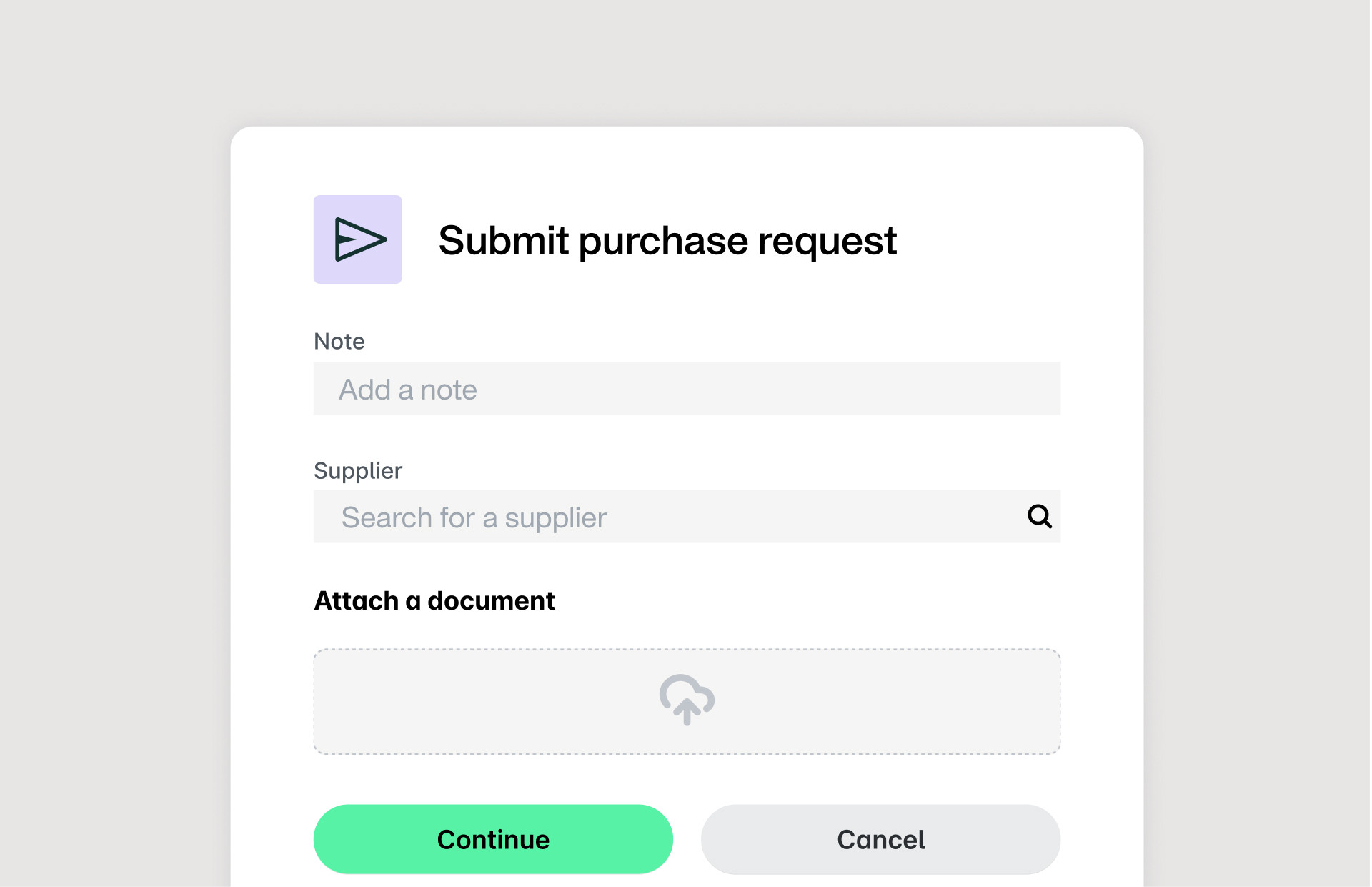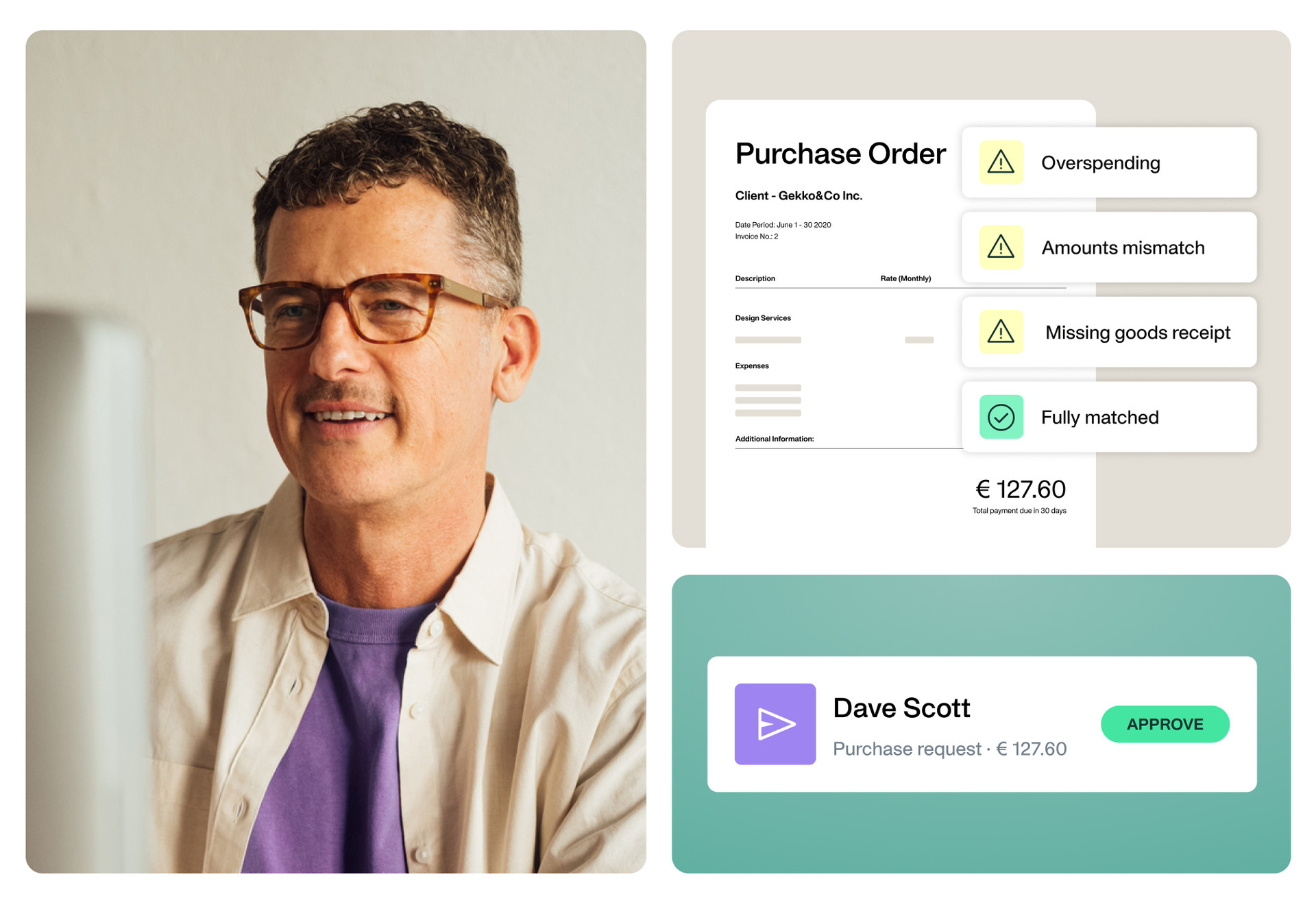
Purchase Orders 101: What are they and how do they work?



Managing purchase orders effectively is a big deal. Smart procurement systems and processes can save you time and money, reduce effort and conflict, and keep the wheels turning regarding pre-approved business spend. The real beauty in these processes? Understanding 1) how to use them and 2) how to fit them into your company's overall financial and operational resilience.
By submitting this form, you agree to receive emails about our products and services per our Privacy Policy.
What is a purchase order?
A purchase order (PO) is a formal, legally binding document that a buyer issues to a supplier to authorize a purchase. It specifies what’s being bought (items/services), quantities, agreed prices, delivery details, and payment terms. The PO becomes a contract once the supplier accepts (explicitly or by fulfilling it). In finance ops, POs create pre-approval and an audit trail, and are used for 2- or 3-way matching before payment.
Take, for example, the last time you were at a restaurant. You likely chose a dish, the waiter wrote it down and then took it to the kitchen.
The above is a simple example of a purchase order in action. In business, a purchase order is a document from a buyer to a seller detailing the items or services they wish to purchase, their quantities, and agreed prices. It's very similar to your restaurant order, but of course, a bit more formal.
Why are purchase orders so important? The main reason is that they serve as a legal record of a transaction between a buyer and a seller, and so help to avoid any misunderstandings or mistakes. With the help of purchase orders (and wider purchase order systems), businesses can maintain clear communication, avoid errors, keep clear audit trails, and increase control and visibility over committed company spend. They can also offer protection to both parties in case of disputes.
Transform the way you spend with integrated procure-to-pay features

Understanding the purchase order process
What are the different steps in the purchase order process? The first step starts with the buyer. They identify a need for goods or services. They then create a purchase order with all the required details, including what they want to buy, how much they need, and the desired delivery date.
The buyer then sends the purchase order to the supplier, who reviews it and decides whether to accept it. Once the order is delivered, the buyer checks it against the purchase order to ensure everything is correct and that they have received the proper service with the right amount.
The process is like a relay race, where the baton is the purchase order, passed from buyer to seller and back again.


How purchase orders work
To be effective, purchase orders should be part of a more comprehensive purchase-to-pay process that supports robust approvals and payments. You can implement different strategies and tools to help this, but some are more in-depth than others regarding features like approval workflows, payment methods, automation, and more.
Purchase orders work best within purchasing processes that include the following:
- Requisition: Initially, an employee within the organization will raise a purchase order requisition citing their need for specific goods or services.
- Approval: Next, there's an approval phase where the finance team or software checks the purchase order and approves (or rejects) the spend per your corporate spend policy.
- Purchase order creation: Once approved, the finance team or software creates a formal purchase order containing details about quantity, description, price, and delivery expectations.
- Purchase order submission and acceptance: The finance team or software then sends the purchase order to the supplier for approval. On accepting, they agree to fulfill the conditions stated, essentially making it an 'order purchase contract.'
- Delivery and inspection: As agreed upon, the supplier delivers said goods or services. The purchaser then inspects these against the specifications communicated earlier to check all is okay.
- Invoice matching and payment: If the inspection is satisfactory, the system or a team member will match the invoices with respective purchase orders before any payment is approved. This step is also known as two or three-way matching.
The process ends with updating your company records and closure post-successful payment completion.
Types of purchase order
Not all purchase orders are the same. Based on the unique requirements of your business and the already existing agreements made with suppliers, there are several different types:
- Standard purchase orders: These are most common and used when details such as pricing, quantity, delivery date, etc., are known at the time of order placement
- Planned purchase orders: Ideal for repeat business with trusted suppliers where frequent specific purchases are anticipated, but exact details about delivery dates might not be known in advance
- Blanket purchase orders: This type allows flexibility with multiple deliveries over time, mainly when exact quantities and delivery schedules aren’t determined upfront
- Contract purchase orders: These are based on supplier contracts specifying terms and conditions, including pricing and duration, but without product or service specifics
- Digital purchase orders: In our digital age, these have become dominant due to their ease of use - this type involves using software tools or platforms to generate electronic purchase orders, which can streamline the purchasing process significantly
Understanding the different types of purchase orders can help businesses simplify their procurement process and reduce manual work. This is vital for ensuring they can focus on more strategic, value-adding initiatives instead.
Legal aspects of purchase orders
One of the most critical aspects of purchase orders is that they are, in a nutshell, a contract and can have legal consequences. Once a seller accepts a purchase order becomes a legally binding agreement. It's like signing a contract to buy a car; you must pay once you've signed.
Businesses on the supplier side must ensure they can fulfill their obligations before accepting a purchase order.


Managing purchase orders
Managing purchase orders is a bit of a tightrope walk. You've got to keep all the balls in the air — tracking orders, maintaining records, communicating with suppliers, and more. It's crucial to have a system in place to ensure everything runs smoothly. This might involve using spreadsheets, databases, or a dedicated procure-to-pay solution, which can even automate much of the work involved.
Tracking and monitoring purchase orders
As mentioned, purchase orders are most effective when part of a broader, more in-depth purchasing or procure-to-pay process. Therefore, easily following up and monitoring purchase orders is crucial to a successful procurement process. Four effective tactics are as follows:
- Go digital: Automate purchase order tracking from creation to fulfillment using tools such as cloud-based order management systems
- Ensure fairness: Maintain order by assigning unique sequential numbers to each purchase order, simplifying the process of using random numbers
- Highlight key milestones: Efficiently manage expectations and deadlines by documenting crucial steps, such as estimated shipping or delivery dates
- Document comprehensively: Record all correspondence and backup messages related to specific purchase orders and any inevitable disagreements between parties
Remember that not every strategy or solution works for every company, so be sure to find one that works for you. Download and fill in our new guide and checklist ‘Perfecting procurement: How to streamline spend management from requisition to payment,’ to assess your current setup and see what you’re missing.
Strategies for maintaining accurate records and documentation
Keeping track of every transaction linked to your purchase orders might initially seem tough. But if you can stick to a few key tactics, it gets much more straightforward:
- Go digital (yep, again): Keep all your purchase order records in a digital system and take advantage of fast access to past information whenever needed.
- Update in real time: Whenever there's a change in a purchase order, make sure to update it immediately. This behavior will keep everyone on the same page.
- Use checklists: Create detailed checklists for each step. They help make sure nothing important gets missed during the process.
These tactics will reduce compliance risk, increase audit efficiency, and preserve accuracy.
Tips for effective communication and collaboration between buyers and suppliers
Clear-cut communication greases the wheels of collaboration. And this is incredibly true for purchase orders.
No matter how you work with suppliers and what systems you use, the following two points are incredibly helpful in ensuring good relationships and positive outcomes.
- Openness and feedback: There should be mutual openness to communication. Issues will inevitably occur at some point when it comes to supply, whether it’s shipment delays, production issues, etc., and both parties must encourage open communication so they can take action to minimize any potential impact
- Details matter: Each party should examine the others’ duties to promote better understanding and avoid errors
Although the two suggestions above seem like a big commitment initially, developing effective cooperation will strengthen your company relations and save time, money, and stress.
Purchase order systems and tools
Now that we're talking about software, let's explore purchase order systems. The purpose of these digital technologies is to make purchase order processes more efficient. These systems can track orders, automate activities, and link with other corporate systems like accounting or inventory management software.
Selecting the correct tool is similar to choosing the ideal car; you must consider your budget, the required features, and how well the tool will integrate with your current setup.
Key features to consider when selecting a purchase order system or tool
Choosing the right electronic solution for your business takes time and effort. Not only are you looking for efficient purchase order processes and automation, but you also want a system that fully connects with everything else you need. You don’t want to use multiple tools for corporate cards, expense management, and procure-to-pay, as you’ll have to look in different places to assess and control your spending, and it can quickly become inefficient and confusing.
Using a complete spend management solution is probably the best option, and some of the key features you must look for should include:
- Corporate cards and controls allow for easy but in-policy payments that fall outside of the purchase order system
- Expense management to support receipt capture and chasing employee reimbursements, and more
- Accounts payable and auto-approvals for invoice and supplier management that fall outside of the purchase order system
- Multi-entity management features like streamlining accounts payable across entities, international payments, and a Group Dashboard where you can check cash flow status at any time
- Integrations, OCR technology, and real-time reconciliation with accounting software or Enterprise Resource Planning (ERP) tools that allow for a fast, accurate month-end without manual data entry
- Adoption and compliance with your corporate spend policy via in-built approval workflows and card controls like spend limits and card freezes
Best practices for purchase order management
You’ve decided to implement a purchase order process. Here are a few tips to help you get the most out of it.
First, streamline your process to reduce errors and improve efficiency. This might involve using templates, automating tasks, training staff, or implementing procure-to-pay software with time-saving automation.
Second, negotiate favorable terms with your suppliers. This could mean securing discounts for bulk purchases or agreeing on good delivery times.
Finally, ensure you comply with all relevant regulations and industry standards. It's like driving — you need to follow the rules of the road to avoid fines and accidents.


Purchase order automation
Switching provider(s) can be daunting if you're in a big business. In contrast, if you're in a growing business, you might avoid implementing a purchase order process altogether. But would things look different if you knew you could automate your purchase order process so it would run smoothly with minimal intervention?
That's the promise of intelligent procure-to-pay with purchase order automation. It can support you to automatically create, approve, track, and match your purchase orders, freeing up time for you to focus on other tasks.
Advantages of automating the purchase order process
Automating purchase order processes obliterates manual work time, giving you more time to focus on high-value tasks. The time you normally spend on recording data can be spent on strategic activities instead.
Error reduction is a big win, too. Without human intervention, miscalculations or transposition mistakes are virtually eliminated. This leads to a higher accuracy rate, ensuring every 'order example' corresponds to its requisition correctly.
Another noteworthy benefit of some automated purchase order systems is the increased prominence of every "purchase order." Every transaction may be tracked in real-time, from beginning to end, using an automated system. This translates into improved decision-making due to readily available knowledge and faster reaction times when problems arise.
Troubleshooting common purchase order challenges
Even with the best systems in place, challenges can arise with purchase orders. You might receive an incorrect order, face delays, or encounter price disputes. The key is having strategies to resolve these issues quickly and effectively. This might involve regular supplier communication, thorough record-keeping, and a clear dispute-resolution process.
The most common issues and problems that can arise during the purchase order process are:
- Incorrect data: A repetitive error-prone issue like incorrect item specifications, quantity, prices, or supplier details that bubble up while processing a purchase order.
- Inherent delay: Timing-related concerns such as late issuance of purchase orders leading to delays in delivery or receiving goods after stipulated deadlines.
- Approval discrepancies: Frequently observed are non-approval or incomplete approval procedures failing to follow given company protocols essential for creating a purchase order.
- Supplier management: Problems with getting accurate pricing from vendors or failing to adhere strictly to agreed-upon terms within their contract.
- Inventory control: Overstocking in anticipation of the rise in demand or under-stocking causing production halts are not unfamiliar issues arising from improper inventory controls.
Strategies and solutions for resolving discrepancies or disputes related to purchase orders
Smooth transactions seldom happen by chance but result from deliberate strategy and good practice.
- Get data right: Ensure accurate data is entered to avoid mistakes.
- Submit orders on time: Stick to deadlines or use automation for faster orders.
- Follow approvals: Stick to the rules for approvals to avoid wrong purchases.
- Build vendor relationships: Good relationships with vendors solve problems and build long-term ties.
- Automate inventory checks: Use automated systems for easier stock control and avoid over/ understocking.
While experience is valuable, these strategies can help tackle common challenges with purchase orders.
Your next steps
Clearly, purchase orders are a vital tool for businesses. They provide a clear record of transactions, help manage purchases, and offer legal protection.
By understanding the purchase order process, choosing the right tools, and following best practices, businesses can streamline operations, reduce errors, and build strong relationships with suppliers.
At Payhawk, our procure-to-pay automation is part of a complete spend management solution that helps customers save time, money, and avoid errors. Learn more about procure-to-pay automation here.
Trish Toovey works across the UK and US markets to craft content at Payhawk. Covering anything from ad copy to video scripting, Trish leans on a super varied background in copy and content creation for the finance, fashion, and travel industries.
Related Articles


The true price of bank-issued cards for finance teams

